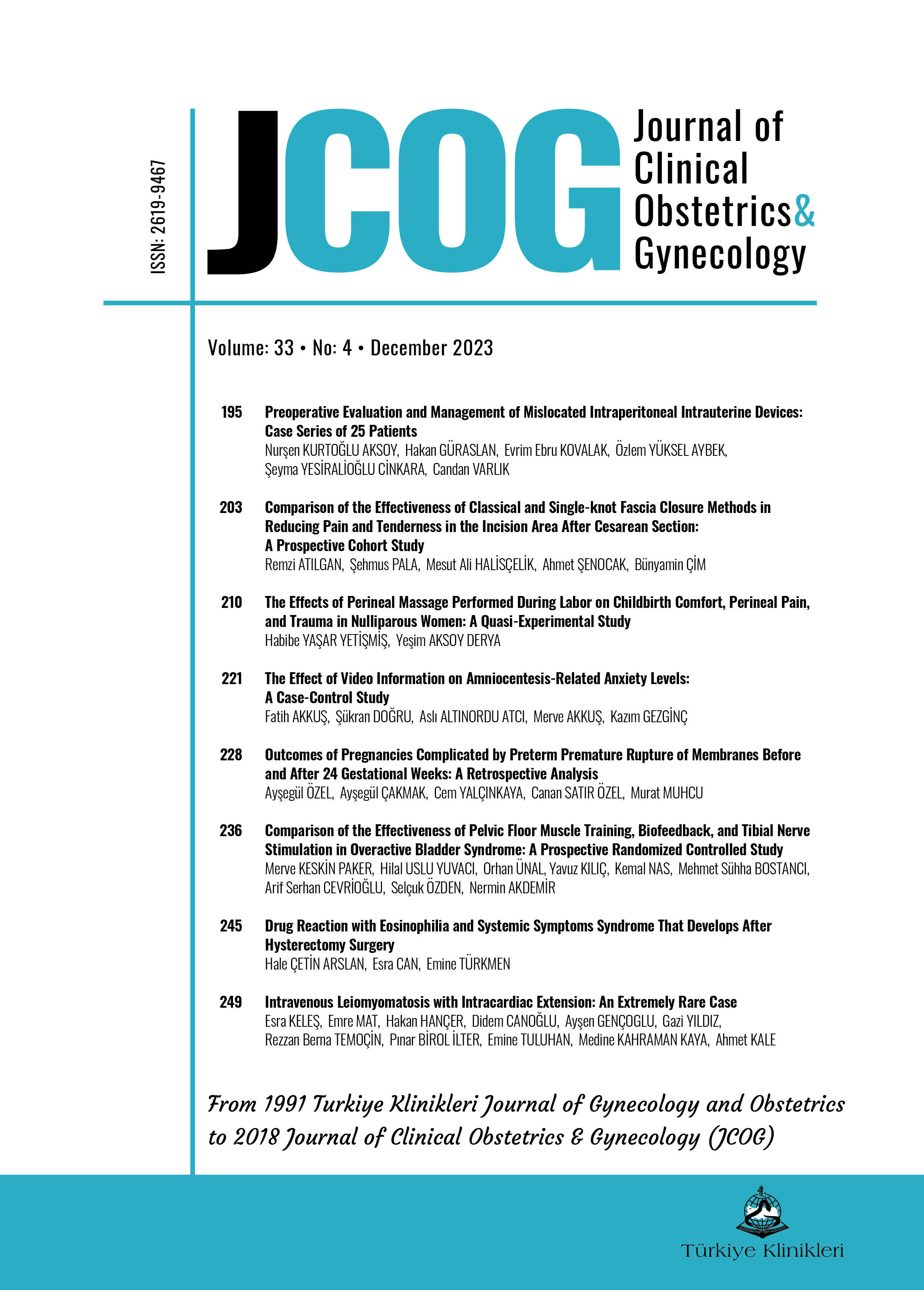Open Access
Peer Reviewed
CASE REPORTS
1302 Viewed1246 Downloaded
Drug Reaction with Eosinophilia and Systemic Symptoms Syndrome That Develops After Hysterectomy Surgery
Received: 02 Dec 2022 | Received in revised form: 19 Sep 2023
Accepted: 25 Sep 2023 | Available online: 09 Oct 2023
JCOG. 2023;33(4):245-8
DOI: 10.5336/jcog.2022-94674
Article Language: EN
Article Language: EN
Copyright Ⓒ 2025 by Türkiye Klinikleri. This is an open access article under the CC BY-NC-ND license (http://creativecommons.org/licenses/by-nc-nd/4.0/)
ABSTRACT
DRESS syndrome, ''drug reaction with eosinophilia and systemic symptoms,'' is a hypersensitivity reaction that can lead to severe organ dysfunction and mortality. Increased reactive metabolites are thought to cause an immunological response due to inadequate detoxification of the responsible drug. The drugs with which the reaction is most frequently observed are anticonvulsants and sulfonamides. It can be fatal with the reuse of some groups of drugs. Early diagnosis of the disease and discontinuation of the responsible drug in the early period of the reaction is essential. Systemic steroids are used in treatment, and intravenous immunoglobulin is used when necessary. We have presented a 43-year-old female patient diagnosed with DRESS syndrome who was using nitrofurantoin because of a Double J catheter.
DRESS syndrome, ''drug reaction with eosinophilia and systemic symptoms,'' is a hypersensitivity reaction that can lead to severe organ dysfunction and mortality. Increased reactive metabolites are thought to cause an immunological response due to inadequate detoxification of the responsible drug. The drugs with which the reaction is most frequently observed are anticonvulsants and sulfonamides. It can be fatal with the reuse of some groups of drugs. Early diagnosis of the disease and discontinuation of the responsible drug in the early period of the reaction is essential. Systemic steroids are used in treatment, and intravenous immunoglobulin is used when necessary. We have presented a 43-year-old female patient diagnosed with DRESS syndrome who was using nitrofurantoin because of a Double J catheter.
REFERENCES:
- Saltzstein SL, Ackerman LV. Lymphadenopathy induced by anticonvulsant drugs and mimicking clinically pathologically malignant lymphomas. Cancer. 1959;12(1):164-82. [Crossref] [PubMed]
- Cacoub P, Musette P, Descamps V, Meyer O, Speirs C, Finzi L, et al. The DRESS syndrome: a literature review. Am J Med. 2011;124(7):588-97. [Crossref] [PubMed]
- Criado PR, Criado RF, Avancini JM, Santi CG. Drug reaction with Eosinophilia and Systemic Symptoms (DRESS) / Drug-induced Hypersensitivity Syndrome (DIHS): a review of current concepts. An Bras Dermatol. 2012;87(3):435-49. [Crossref] [PubMed]
- Bocquet H, Bagot M, Roujeau JC. Drug-induced pseudolymphoma and drug hypersensitivity syndrome (Drug Rash with Eosinophilia and Systemic Symptoms: DRESS). Semin Cutan Med Surg. 1996;15(4):250-7. [Crossref] [PubMed]
- Knowles SR, Dewhurst N, Shear NH. Anticonvulsant hypersensitivity syndrome: an update. Expert Opin Drug Saf. 2012;11(5):767-78. [Crossref] [PubMed]
- Kardaun SH, Sidoroff A, Valeyrie-Allanore L, Halevy S, Davidovici BB, Mockenhaupt M, et al. Variability in the clinical pattern of cutaneous side-effects of drugs with systemic symptoms: does a DRESS syndrome really exist? Br J Dermatol. 2007;156(3):609-11. [Crossref] [PubMed]
- Kardaun SH, Sekula P, Valeyrie-Allanore L, Liss Y, Chu CY, Creamer D, et al; RegiSCAR study group. Drug reaction with eosinophilia and systemic symptoms (DRESS): an original multisystem adverse drug reaction. Results from the prospective RegiSCAR study. Br J Dermatol. 2013;169(5):1071-80. [Crossref] [PubMed]
- Choi TS, Doh KS, Kim SH, Jang MS, Suh KS, Kim ST. Clinicopathological and genotypic aspects of anticonvulsant-induced pseudolymphoma syndrome. Br J Dermatol. 2003;148(4):730-6. [Crossref] [PubMed]
- Moling O, Tappeiner L, Piccin A, Pagani E, Rossi P, Rimenti G, et al. Treatment of DIHS/DRESS syndrome with combined N-acetylcysteine, prednisone and valganciclovir--a hypothesis. Med Sci Monit. 2012;18(7):CS57-62. [Crossref] [PubMed] [PMC]
- Yalcın M, Kurt C, Karakok Gungor H. Fatal DRESS syndrome withour eosinophilia after coronary artery bypass grafting. Turkiye Klinikleri J Dermatol. 2020;30(2):66-8. [Crossref]
- Yang CY, Dao RL, Lee TJ, Lu CW, Yang CH, Hung SI, et al. Severe cutaneous adverse reactions to antiepileptic drugs in Asians. Neurology. 2011;77(23):2025-33. [Crossref] [PubMed]
- Chen YC, Chang CY, Cho YT, Chiu HC, Chu CY. Long-term sequelae of drug reaction with eosinophilia and systemic symptoms: a retrospective cohort study from Taiwan. J Am Acad Dermatol. 2013;68(3):459-65. [Crossref] [PubMed]
- Eshki M, Allanore L, Musette P, Milpied B, Grange A, Guillaume JC, et al. Twelve-year analysis of severe cases of drug reaction with eosinophilia and systemic symptoms: a cause of unpredictable multiorgan failure. Arch Dermatol. 2009;145(1):67-72. [Crossref] [PubMed]
MENU
POPULAR ARTICLES
MOST DOWNLOADED ARTICLES





This journal is licensed under a Creative Commons Attribution-NonCommercial-NoDerivatives 4.0 International License.










